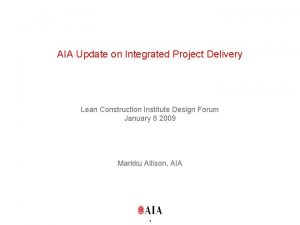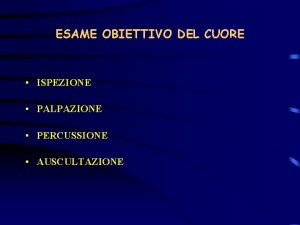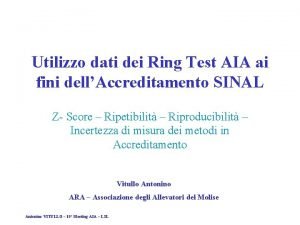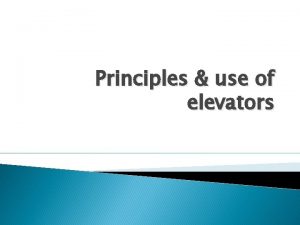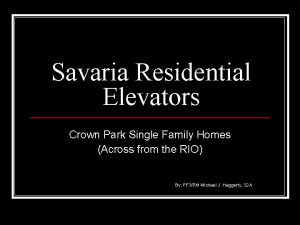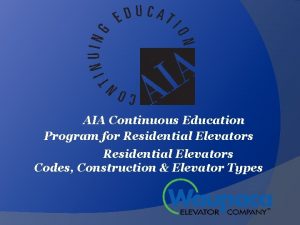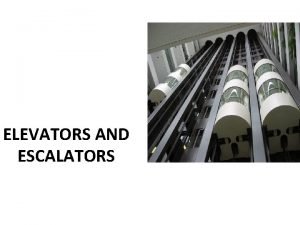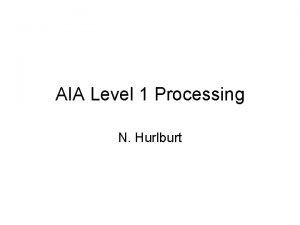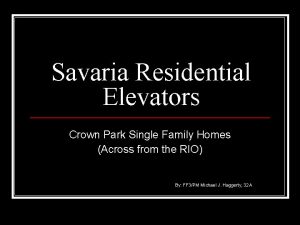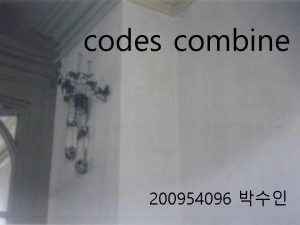AIA Continuous Education Program for Residential Elevators Codes







































































- Slides: 71

AIA Continuous Education Program for Residential Elevators Codes, Construction & Elevator Types

An American Institute of Architects (AIA) Continuing Education Program q Course Format: This is a structured, Face to Face course. q Course Credit: (1) Health Safety & Welfare (HSW) Learning Unit (LU) q Completion Certificate: A copy is sent to you by email upon request. When you fill out the Form B please indicate if you need one. Also please make sure the information you provide is legible. q Design professional’s certificates of completion are available upon request.

�Course Sponsor Waupaca Elevator Co. Inc. 1726 N. Ballard Rd. Suite 1 Appleton, WI 54911 (920) 991 -9082 or (800) 238 -8739 Email: info@waupacaelevator. com Website: www. waupacaelevator. com

Course Content � � � � Why Specify a Residential Elevator in a Home? Residential Elevator Codes & Standards Construction Requirements Drive Systems Rail Systems Cab Sizes & Types Options

Why Specify An Elevator In A Home ?

� Residential elevators provide your client access to all levels of a home. � Residential elevators are an easier and safer way for your clients to travel. � Ideal for clients that are seniors and people who are mobility challenged.

� Residential elevators are not just for luxury homes. They are an affordable necessity. Average Cost for 2 –stop � residential elevator is $20 K -$25 K Installed � � Residential elevators will increase the marketability & resale value of a home.

Elevators Can Be Visually Appealing

Elevator Market Demographics Market is Segmented into Three Groups � Baby Boomers (Largest Segment) � Seniors 65+ � Mobility Challenged

Elevator Market Demographics � � � � Active Adult 75 Million Baby Boomers 35 Million Seniors 65+ 15% Growth in 55+ Aging in Place 83% of Americans 45+ want to stay in residence as long as possible Limited mobility within current home is a serious concern among Americans 45+ 52% of New Homes are Multi-levelled

Age 65 Population Trend Age 65 & Up Population Trend Population 7 000 California 6 000 Florida 5 000 Texas 4 000 New York. 3 000 Virginia 2 000 North Carolina 1 000 Arizona 0 Year 1995 2000 2005 2015 2025 South Carolina Alabama Source: Census Bureau, Characteristics of New Homes Completed SOC data for 2006.

Elevator Market Demographics � Multi-Generational Living � Baby Boomers Having Parents Move In with Them � Long & Short Term Care Facilities are Expensive � Mobility Concerns for Loved Ones are Eliminated

Installation Time: How long does it take to install a residential elevator? On average one level or stop per day.

Residential Elevator Codes & Standards

Residential Elevator Codes & Standards Residential Elevators are to be manufactured, designed, & installed to the following: � ASME – American Society of Mechanical Engineers �ASME A 17. 1 -2016 ○ (Your local jurisdiction may be inspecting to a previous version) �Section 5. 3 Private Residential Elevators

Residential Elevator Codes & Standards Residential Elevators are to be manufactured, designed, & installed to the following: NEC – National Electric Code �Article 620 – Elevators, Dumbwaiters, Escalators, Moving Walks, Wheelchair & Stairchair Lifts � ANSI – American National Standards Institute � IBC – International Building Code �

Residential Elevator Code Requirements � Maximum Rated Speed: 40 fpm � Maximum Travel: 50 FT � Un-interruptible Power Supply (UPS) � Phone Connection to the Elevator Car � Hoistway Doors Must be Equipped with a Locking Device

Code Requirements � Minimum Load Capacity for 12 Sq FT Car: 350 lbs or 40 lbs Per Square Foot � Minimum Load Capacity for Cars Over 12 Sq Ft - 62. 5 Lbs Per Square Foot � Check with local jurisdictions for maximum accepted weight capacity.

Code Requirements & Car Sizes Standard Car Sizes � � � 36 x 48 – 12 Square Feet 40 x 54 - 15 Square Feet 36 x 60 - 15 Square Feet Maximum Square Footage for Interior Car is Limited to 15 Ft 2 � If Interior Square Footage Exceeds 15 Ft 2 a Variance is Required from Local Jurisdiction �

Code Requirements Elevator ¾” – 4” Rule � The Distance Between the Hoistway Door Face & the Hoistway Edge of the Landing Sill must be No More than ¾” inch � The Clearance Between the Hoistway Door Face & the Elevator Car Gate must reject a 4” ball � The gate must not deflect more than ¾” inch � Safety Issue – Non Adherence Can Result in Entrapment Between Hoistway Door & Car Gate Causing Injury or Death

Code Requirements • Note 1 – Distance between the face of the hoistway door and edge of landing sill shall not be more than ¾” • Note 2 – Must reject a 4” diameter ball at all points when hoistway door and car gate are both fully closed

Code Requirements � Machine Room is Required in Most Jurisdictions � The Controller Requires Minimum Clear Space of 30” X 36” Directly in Front of the Controller

Construction Requirements

House Plans Without an Elevator

House Plans With an Elevator

Construction Requirements � Universal Design Option: Stack Closets on Each Level of Home to Allow Buyer or Future Owner the Option of already having an Elevator Hoistway. � The Universal Design Option allows for Current or Future Plans for a Home Elevator � Typical Home Elevator Hoistway Dimension is 5’ x 5’

Universal Design 1 st & 2 nd floor stacked directly above one another � Closet size to match elevator shaft size � 96” ceiling height on top floor for adequate overhead � Backing for Rail Wall Framing is Double Stacked 4 -1 ¾” x 9 -½” Lumber or LVL - Glued & Screwed �

Universal Design Install removable or temporary flooring in closet at each landing � Offset doors for elevator requirements � Include phone line & electrical for elevator equipment � 8” pit (minimum) in slab with temporary flooring �

Construction Requirements Rail Wall Support

Construction Requirements � Minimum Hoistway Ceiling Height is 12 or 26 Inches Over Cab Height � Pit Required for Most Residential Elevators � Pit Concrete PSI: 3500 PSI

Types of Elevator Drive Systems

Roped Hydraulic Advantages: � Quiet Operation � Smooth Ride � Remote Machine Room Disadvantages: � Slightly Higher Cost � Longer Install � Maintenance

Winding Drum (machine roomless) Advantages: � Affordability � Smooth Ride � Proven Technology Disadvantages: � Some Noise

Winding Drum Remote Machine Room � Allows Multiple Machine Room Locations Ø Behind the Rail Ø Adjacent to Rail Ø In the Pit Ø In the Attic

Winding Drum Reduced Machine Room � Behind Rail Wall � Motor & Drum Enclosed in Steel Casing

Chain Driven Counter Weight Advantages: � Low Energy Consumption Disadvantages: � Noisy � Poor Ride Quality � Some Cab Movement

Gearless Counter Weight Advantages: � Quiet � Smooth Ride � Disadvantages: � Very Expensive � Longer Install � Not Approved in every State �

Types of Elevator Rail Systems

T - Rail Advantages: � T- Rail - Industry Standard � 6 lb or 8 lb Rail � Dual Rails Give Stable Ride � Rollers Provide Smooth Ride � Easier to Adapt to Rail Wall Imperfections Disadvantages: � Rollers Will Wear Unevenly When Elevator Not in Use for Prolonged Period of Time

T - Rail RAIL SEGMENT

T - Rail RAIL SEGMENT

J - Rail Advantages: � Economical � Dual Rails Give Stable Ride � J- Rail – Quicker Installation � Cross Sections Attached to Rail � Shoe Glides Provide Smooth Ride Disadvantages: � Shoe Glide Wear Out

J - Rail

C - Rail Advantages: � Economical � Suitable for Small Hoistway Applications Disadvantages � Elevator Cab Will Have Some Movement � Noise � Single Rail Ride Not as Smooth as Other Rail Systems

C - Rail

Safety Features � Hoistway Door Interlocks � Slack Cable Device/Brakes � Elevator Gates � Automatic Car Lights � Push Button Emergency Alarm � Battery Backup with Light & Alarm � Elevator Phone � Limit Switches

EMI Interlocks Door interlocks prevent opening of elevator door when the cab is not at the designated landing.

Safeties or Brakes

Gates Wood or Vinyl 3 Panel See Through All Panel Clear or Bronze Aluminum Perforated

Gates � Collapsible Gates are prohibited in some states � For Safety Reasons Recommend Light Curtain

Cab Openings, Sizes & Types

Car Openings

Typical Interior Cab Choices Unfinished � Finished � Custom Finished �

Unfinished � Unfinished Veneer � Birch � Oak � Maple � Alder � Melamine � Oak

Unfinished � Unfinished Bamboo �Flush bamboo veneer walls and ceiling

Finished Stained or Painted � Veneer & Thermofoils �Oak �Birch �Cherry �Mahogany �Maple �Walnut �Alder �

Finished � Natural lacquered �Oak �Birch �Cherry �Mahogany �Maple �Walnut �Alder

Custom Finished � Solid Raised Panel Hardwoods with Mirror Inserts

What types of options are available?

Additional Features � � � Car Operating Panel & Hall Stations Brass or Stainless Handrail Phone Boxes Car Lights Power Gate Operator Matching Wood Ceiling

Control Operating Panels Polished Muntz car operating panel with digital LED position indicator, integrated phone and emergency light. Standard features: Rectangle shape with large buttons, light switch, alarm button and emergency stop. Options: Three unique profiles, integrated phone, emergency light, key lock, and LED position indicator. Horizontal panel design is also available.

Hall Stations can match car operating panels. Standard single button with “Call / In Use” indicator. Options include a key lock, “Car Here” button, LED position indicator and weatherproof. The NEMA 4 exterior weatherproof hall station is only available in Brushed Stainless finish.

Handrails Standard solid wood handrails (round or flat) are available to match your cab interior. Optional metal handrails (round or flat) are available in Brushed and Polished Stainless Steel, Brushed and Polished Muntz and Dark Oxide (flat only).

Phone Boxes Phone boxes and integrated phone panels are available to match car operating panels or wood finish.

LED Lights – Two lights are typically the standard for an elevator car. Four lights would be an upgrade.

Power Gate Operator Closes and Opens the Gate Automatically

Residential Elevator Pricing Factors Effecting Pricing Ø Type of Drive System & Rail System Ø Unfinished vs. Finished Cab Ø Number of Stops & Travel Distance Ø Car Openings Ø Options & Upgrades Ø Permits, Inspections & Taxes Ø New Construction vs. Remodel Ø Travel Time to Job Site Ø Service or Maintenance Contract Ø Regional Location of Project – California vs. Kentucky

Residential Elevator Pricing Typical Range Price for Installation Ø 2 – Stop: $18, 000 to $30, 000 Ø 3 – Stop: $20, 000 to $35, 000 This Does Not Include the Cost of Hoistway Construction

? Questions ?

Contact Information: Waupaca Elevator Co. , Inc. � 1726 N. Ballard Road, Suite 1 Appleton, WI 54911 � By Phone: (920) 991. 9082 (800) 238. 8739 � General information & Sales inquiries info@waupacaelevator. com

Thank You For Your Time & Consideration
 Rei elevator
Rei elevator Salt lake city building code
Salt lake city building code Pinewood detox
Pinewood detox Rdap 5 rules of rational thinking
Rdap 5 rules of rational thinking Aia baseball rules
Aia baseball rules Liiliakukk
Liiliakukk Chinmaya somnath
Chinmaya somnath Aia 131
Aia 131 Aia integrated project delivery
Aia integrated project delivery Aia di ottusità assoluta
Aia di ottusità assoluta Aia 360 test menu
Aia 360 test menu Tutor arbitro
Tutor arbitro Aia 201
Aia 201 Antonino vitullo
Antonino vitullo Nilai unit equity fund aia
Nilai unit equity fund aia Patent effective filing date
Patent effective filing date Acia
Acia Laboratorio standard latte
Laboratorio standard latte Aia
Aia Aia fort worth
Aia fort worth Present past continuous
Present past continuous Past simple future simple present simple
Past simple future simple present simple Hockey stick elevator or london hospital elevator
Hockey stick elevator or london hospital elevator Wedge principle in tooth extraction
Wedge principle in tooth extraction Single family home elevators
Single family home elevators Elevators definition
Elevators definition Vexpro 775
Vexpro 775 Public consulting group
Public consulting group Formuö
Formuö Typiska drag för en novell
Typiska drag för en novell Nationell inriktning för artificiell intelligens
Nationell inriktning för artificiell intelligens Returpilarna
Returpilarna Varför kallas perioden 1918-1939 för mellankrigstiden?
Varför kallas perioden 1918-1939 för mellankrigstiden? En lathund för arbete med kontinuitetshantering
En lathund för arbete med kontinuitetshantering Underlag för särskild löneskatt på pensionskostnader
Underlag för särskild löneskatt på pensionskostnader Tidbok
Tidbok Sura för anatom
Sura för anatom Förklara densitet för barn
Förklara densitet för barn Datorkunskap för nybörjare
Datorkunskap för nybörjare Boverket ka
Boverket ka Debattartikel mall
Debattartikel mall Magnetsjukhus
Magnetsjukhus Nyckelkompetenser för livslångt lärande
Nyckelkompetenser för livslångt lärande Påbyggnader för flakfordon
Påbyggnader för flakfordon Vätsketryck formel
Vätsketryck formel Svenskt ramverk för digital samverkan
Svenskt ramverk för digital samverkan Jag har nigit för nymånens skära
Jag har nigit för nymånens skära Presentera för publik crossboss
Presentera för publik crossboss Teckenspråk minoritetsspråk argument
Teckenspråk minoritetsspråk argument Bat mitza
Bat mitza Treserva lathund
Treserva lathund Epiteltyper
Epiteltyper Bästa kameran för astrofoto
Bästa kameran för astrofoto Centrum för kunskap och säkerhet
Centrum för kunskap och säkerhet Byggprocessen steg för steg
Byggprocessen steg för steg Bra mat för unga idrottare
Bra mat för unga idrottare Verktyg för automatisering av utbetalningar
Verktyg för automatisering av utbetalningar Rutin för avvikelsehantering
Rutin för avvikelsehantering Smärtskolan kunskap för livet
Smärtskolan kunskap för livet Ministerstyre för och nackdelar
Ministerstyre för och nackdelar Tack för att ni har lyssnat
Tack för att ni har lyssnat Vad är referatmarkeringar
Vad är referatmarkeringar Redogör för vad psykologi är
Redogör för vad psykologi är Matematisk modellering eksempel
Matematisk modellering eksempel Tack för att ni har lyssnat
Tack för att ni har lyssnat Borra hål för knoppar
Borra hål för knoppar Orubbliga rättigheter
Orubbliga rättigheter Fr formel
Fr formel Tack för att ni har lyssnat
Tack för att ni har lyssnat Rita perspektiv
Rita perspektiv Ledningssystem för verksamhetsinformation
Ledningssystem för verksamhetsinformation Tobinskatten för och nackdelar
Tobinskatten för och nackdelar








